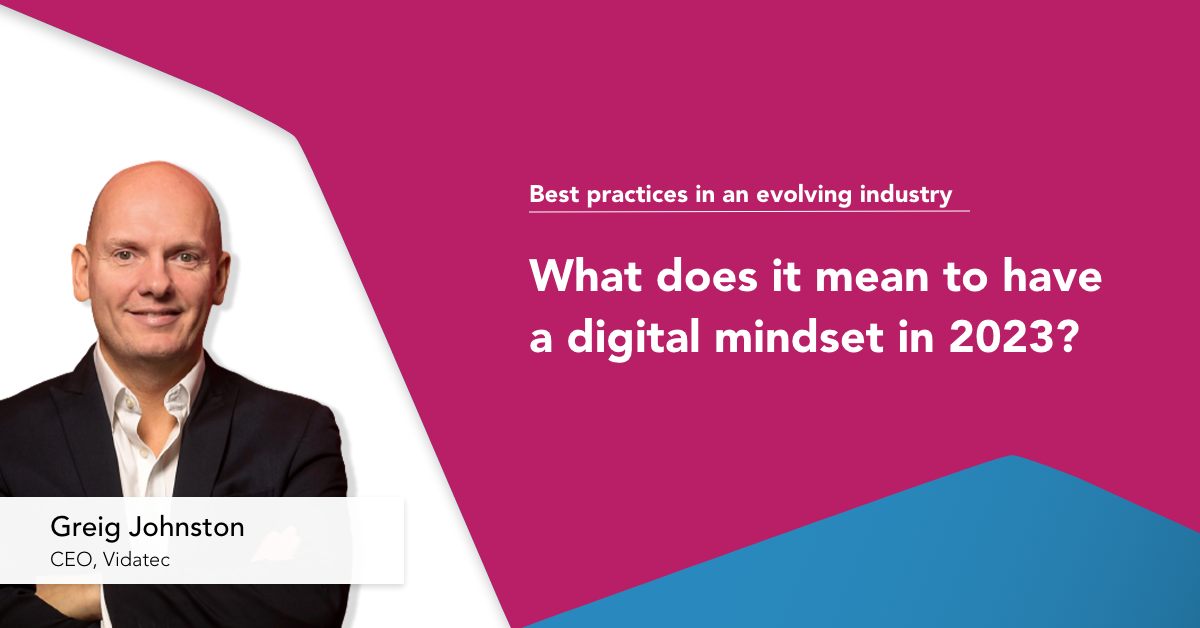“It’s fashionable for organisations to speak about their digital mindset, but in reality, it’s not about the company, it’s about the individuals who work there...”
In his recent LinkedIn article, What does it mean to have a digital mindset in 2023? Vidatec CEO, Greig Johnston, mentioned that even in the world in IT, (an industry rarely lauded for its people-friendly approach) change must start with people.
Full disclosure: Vidatec is Insights sister company. Insights focuses on people and Vidatec focuses on… technology? Actually, it also focuses on people, albeit in a different way.
Given Vidatec’s role in the Insights group as our technological counterpart, it should come as no surprise that its CEO takes a person-centric approach to digital transformation.
“It’s not as though a company gets a new CIO, and can therefore adopt a digital mindset overnight,” he explains. “You can’t force people to think a certain way. It’s clearly a big part of culture and education.”
The next time you’re chatting with your CIO or IT manager, it might be worth remembering that infamous stat from McKinsey, BCG, KPMG and Bain & Company that between 70% and 95% of digital transformations fail.
Part of that failure rate may have to do with what Greig talks about. For an organisation to adopt a digital mindset, it requires more than investing in MS Teams or Slack and expecting everyone to be on board overnight.
It must be integrated at a strategic and leadership level and tied to organisational goals. And like any culture change, it requires developing engagement programmes that centre around supporting employees.
Self-awareness in the workplace (and the role of learning experiences like Insights Discovery)
“Awareness is the greatest agent of change”
-Eckert Tolle
Transformation is growth, and growth is, by its very definition, incremental, and it’s got to start somewhere: That starting point is awareness.
The idea that a high level of self-awareness and awareness at work help people cope with change is hardly novel, it’s part of the human condition. Right up there with the fact that people often have negative thoughts about change and thrusting change upon your employee base with little preparation isn’t likely to go well.
That’s why the first step – the starting point – is a period of preparation where organisations focus on strengthening communication skills and enhancing employees’ emotional intelligence and their ability to collaborate with others.
This is beyond an internal communications programme (also important, but passive, from an employee’s perspective.) Getting back to awareness, it’s even beyond one-step psychometric profiling, which, while helpful, has limited value unless your people are given the opportunity to learn how to apply to their new-found awareness in the workplace.
Insights flagship programme, Insights Discovery, is a psychometric methodology, but it has a few clear advantages that are necessary to employ prior to workplace transformation.
Meet people where they’re at, improve their self-awareness, then move them forward together
Insights Discovery uses simple language to describe complex concepts. It’s called the language of colour energies, and it enables a common language for describing ourselves and others to spread effortlessly throughout an organisation.
The result? Productive teams made up of self-aware individuals. Easier (less emotionally charged) conversations where people can feel free to express their thoughts and feelings in a supportive way, confident about the value they bring to the team, and just as important; the value that others bring to the team.
When people have a common and non-judgemental way to express themselves (or to make sense of others’ behaviours), those hard conversations that happen during workplace transformations are easier. People acquire a basic toolkit to approach what could be frustrating or awkward situations.
For example, that new P/A clerk who drives you crazy with constant questions or the project coordinator who never stops chatting.
Now imagine if…
- That P/A clerk led with cool blue energy, which would mean they likely appreciate having enough data to make the right decision. They may feel they’re supporting you by asking all those questions – it means they are less likely to make a mistake on your account.
If the questions are difficult to deal with, perhaps you could send itemized emails and that would do the trick.
Or;
- That project coordinator led with a sunshine yellow colour energy, which means they likely value feeling involved and building relationships. They may want you to feel like you are a valued part of the team and do this by chatting.
If the chit-chat is taking up too much time, perhaps you could schedule a dedicated lunch to get to know each other but doesn’t interfere with your day to day working schedule.
Greater awareness = better relationships, and you never know, that new P/A clerk might very well become your best ally at work.
The pitfalls of digital transformation are complex, especially when it comes to people
On the surface, it’s a simple concept, yet one that's fraught with complexity in application. It is not uncommon for companies to turn to this kind of person-centred work the second time around - after their first attempt at digital transformation failed.
That’s why Greig’s comments ring true and should come as a PSA to every L&D and IT team. He sums it up nicely:
“This kind of shift requires an engagement programme centred around supporting people and is tied to a larger change agenda. Organisations that are committed to bringing their people along on that journey are, in my opinion, more likely to succeed.”
Read Vidatec's article on LinkedIn >


